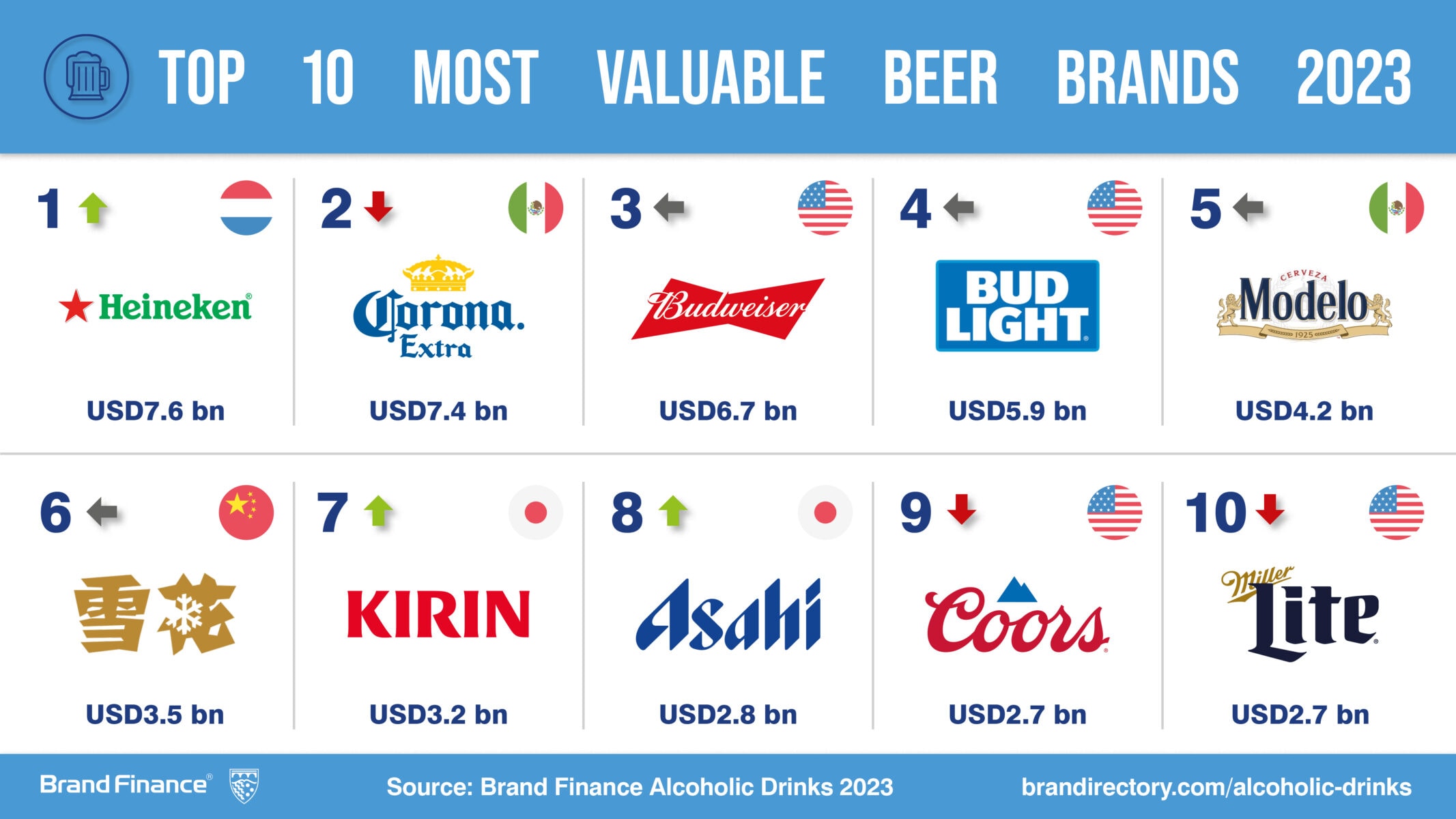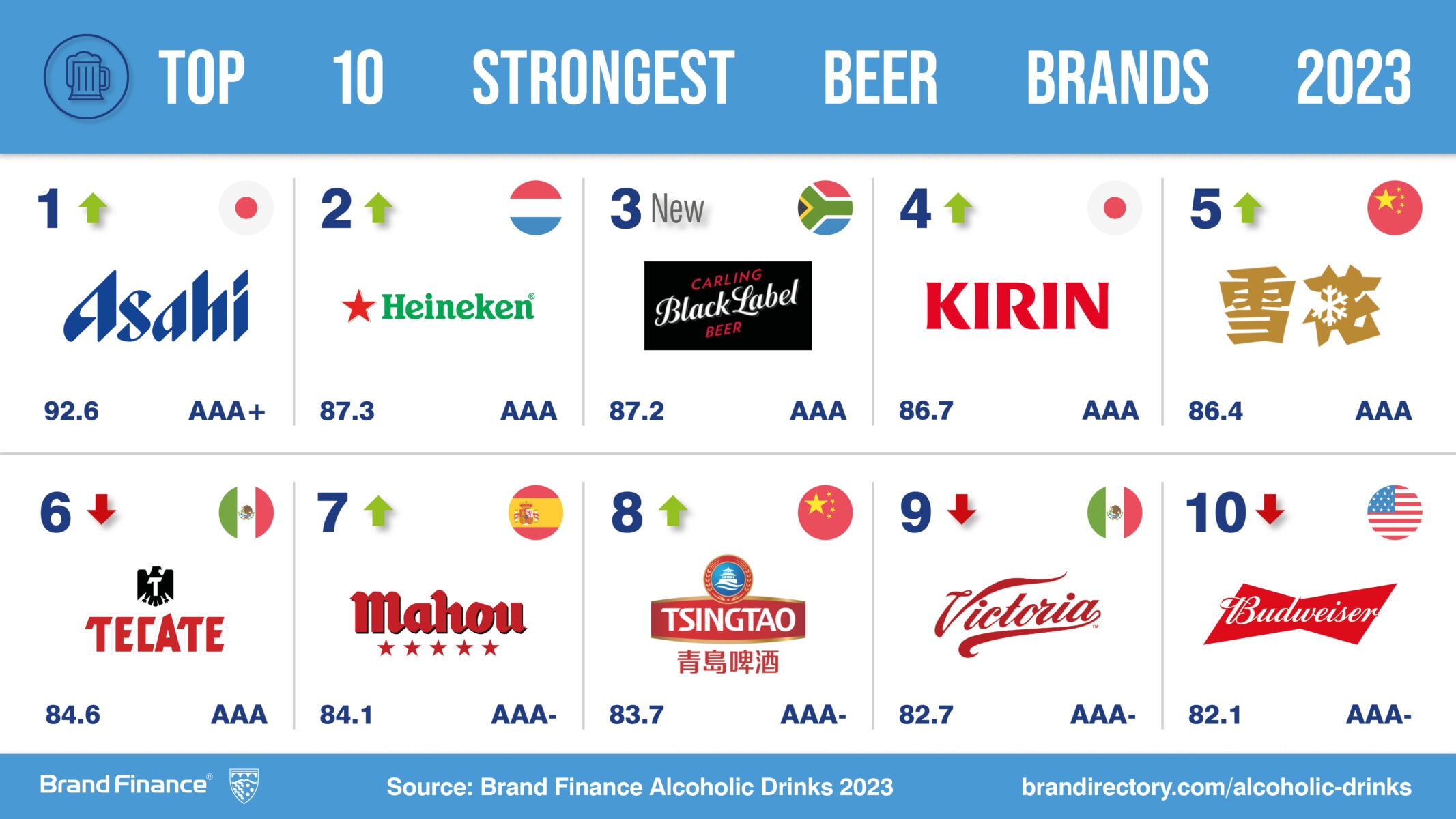View the full Brand Finance Alcoholic Drinks 2023 report here
Heineken overtakes the competition to become the world’s most valuable beer brand, valued at US$7.6 billion
Heineken (brand value up 10% to USD7.6 billion) has overtaken Corona Extra (brand value up 6% to USD7.4 billion) to become the world’s most valuable beer brand. Despite the inflationary pressures being faced by consumers, beer brands continue to see brand value growth. Further, Heineken also ranked second in terms of brand strength.
Every year, leading brand valuation consultancy Brand Finance puts 5,000 of the biggest brands to the test, and publishes over 100 reports, ranking brands across all sectors and countries. The world’s top 50 most valuable and strongest Beer brands are included in the annual Brand Finance Beer 50 2023 ranking.
Henry Farr, Associate Director, Brand Finance said:
“It seems like beer drinkers are not necessarily drinking more, but instead, are drinking better. Visits to bars and restaurants are becoming less regular and less spontaneous, meaning many consumers are looking to trade-up on their beer of choice, prioritising taste and quality over price. Beer brands that are delivering on high quality premium lagers seem to be doing well.”

Asahi isn’t bitter, earning world’s strongest beer brand title with a AAA+ rating and highest Sustainability Perceptions Score
In addition to calculating brand value, Brand Finance also determines the relative strength of brands through a balanced scorecard of metrics evaluating marketing investment, stakeholder equity, and business performance. Compliant with ISO 20671, Brand Finance’s assessment of stakeholder equity incorporates original market research data from over 100,000 respondents in 38 countries and across 31 sectors.
Asahi (brand value up 11% to USD2.8 billion) is the world’s strongest beer brand, earning a brand strength index score of 92.6 out of 100, and a corresponding AAA+ rating. As Japan’s most popular beer brand, regional support has been a key driver in developing brand strength.

Further, as part of its analysis, Brand Finance assesses the role that specific brand attributes play in driving overall brand value. One such attribute is sustainability. Brand Finance assesses how sustainable specific brands are perceived to be, represented by a ‘Sustainability Perceptions Score’. The value that is linked to sustainability perceptions, the ‘Sustainability Perceptions Value’, is then calculated for each brand.
Asahi has the highest Sustainability Perceptions Score, at 5.65 out of 10, of any brand included in the Beers 50 2023 ranking. Closely behind was another Japan-based brand, Kirin (ranked 7th with a brand value USD3.2 billion).
Tsingtao and Zhujiang from China giving the buzz with two fastest brand value growth around global beer market
Zhujiang (brand value up 44% to US$680 million) claims the title of beer’s fasted-growing brand, followed by Tsingtao (up 39% to US$2.1 billion). Zhujiang grew this past year, in part, thanks to its improved standing with younger, more price-sensitive consumers. While competitors have opted for price hikes, Zhujiang has maintained stable beer prices, offering a quality, mid-price alternative. Tsingtao’s impressive brand value growth links directly to the brand’s revitalised business model. In 2022, Tsingtao launched over 250 taverns and introduced the brand’s new and immersive customer-centric strategy.
View the full Brand Finance Alcoholic Drinks 2023 report here
Brand Finance is the world’s leading brand valuation consultancy. Bridging the gap between marketing and finance, Brand Finance evaluates the strength of brands and quantifies their financial value to help organisations make strategic decisions.
Headquartered in London, Brand Finance operates in over 25 countries. Every year, Brand Finance conducts more than 6,000 brand valuations, supported by original market research, and publishes over 100 reports which rank brands across all sectors and countries.
Brand Finance also operates the Global Brand Equity Monitor, conducting original market research annually on 6,000 brands, surveying more than 175,000 respondents across 41 countries and 31 industry sectors. By combining perceptual data from the Global Brand Equity Monitor with data from its valuation database — the largest brand value database in the world — Brand Finance equips ambitious brand leaders with the data, analytics, and the strategic guidance they need to enhance brand and business value.
In addition to calculating brand value, Brand Finance also determines the relative strength of brands through a balanced scorecard of metrics evaluating marketing investment, stakeholder equity, and business performance, compliant with ISO 20671.
Brand Finance is a regulated accountancy firm and a committed leader in the standardisation of the brand valuation industry. Brand Finance was the first to be certified by independent auditors as compliant with both ISO 10668 and ISO 20671 and has received the official endorsement of the Marketing Accountability Standards Board (MASB) in the United States.
Brand is defined as a marketing-related intangible asset including, but not limited to, names, terms, signs, symbols, logos, and designs, intended to identify goods, services, or entities, creating distinctive images and associations in the minds of stakeholders, thereby generating economic benefits.
Brand strength is the efficacy of a brand’s performance on intangible measures relative to its competitors. Brand Finance evaluates brand strength in a process compliant with ISO 20671, looking at Marketing Investment, Stakeholder Equity, and the impact of those on Business Performance. The data used is derived from Brand Finance’s proprietary market research programme and from publicly available sources.
Each brand is assigned a Brand Strength Index (BSI) score out of 100, which feeds into the brand value calculation. Based on the score, each brand is assigned a corresponding Brand Rating up to AAA+ in a format similar to a credit rating.
Brand Finance calculates the values of brands in its rankings using the Royalty Relief approach – a brand valuation method compliant with the industry standards set in ISO 10668. It involves estimating the likely future revenues that are attributable to a brand by calculating a royalty rate that would be charged for its use, to arrive at a ‘brand value’ understood as a net economic benefit that a brand owner would achieve by licensing the brand in the open market.
The steps in this process are as follows:
1 Calculate brand strength using a balanced scorecard of metrics assessing Marketing Investment, Stakeholder Equity, and Business Performance. Brand strength is expressed as a Brand Strength Index (BSI) score on a scale of 0 to 100.
2 Determine royalty range for each industry, reflecting the importance of brand to purchasing decisions. In luxury, the maximum percentage is high, while in extractive industry, where goods are often commoditised, it is lower. This is done by reviewing comparable licensing agreements sourced from Brand Finance’s extensive database.
3 Calculate royalty rate. The BSI score is applied to the royalty range to arrive at a royalty rate. For example, if the royalty range in a sector is 0-5% and a brand has a BSI score of 80 out of 100, then an appropriate royalty rate for the use of this brand in the given sector will be 4%.
4 Determine brand-specific revenues by estimating a proportion of parent company revenues attributable to a brand.
5 Determine forecast revenues using a function of historic revenues, equity analyst forecasts, and economic growth rates.
6 Apply the royalty rate to the forecast revenues to derive brand revenues.
7 Discount post-tax brand revenues to a net present value which equals the brand value.
Brand Finance has produced this study with an independent and unbiased analysis. The values derived and opinions presented in this study are based on publicly available information and certain assumptions that Brand Finance used where such data was deficient or unclear. Brand Finance accepts no responsibility and will not be liable in the event that the publicly available information relied upon is subsequently found to be inaccurate. The opinions and financial analysis expressed in the study are not to be construed as providing investment or business advice. Brand Finance does not intend the study to be relied upon for any reason and excludes all liability to any body, government, or organisation.
The data presented in this study form part of Brand Finance's proprietary database, are provided for the benefit of the media, and are not to be used in part or in full for any commercial or technical purpose without written permission from Brand Finance.